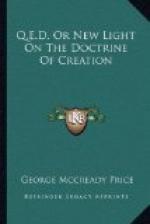The theory of the atoms with their inherent and unchangeable properties, which prevailed during the greater part of the nineteenth century, naturally led us to look upon these properties as inherent in the things themselves. This was indeed materialism. This view, however, constantly impelled us to find out the essential differences between the various kinds of atoms, so as to “account for” their varying behaviors. And no matter how far we push such inquiries, this materialistic attitude of mind will control us so long as we think we are dealing with substances which are intrinsically different. If the differences are innate or inherent in the things themselves, we must naturally endeavor to find out why and how they are different; and no matter how far we go along this road we are always headed in the direction of stark materialism. On the other hand, to say that the “properties” of the atoms are not inherent in themselves, but are imposed on them by an external ceaselessly acting power, the will of the Creator, would be in full accord with Biblical theism; and then we might naturally say that the ultimate particles of which matter is composed may well be regarded as alike and mere duplicates of one another. And this, as we have seen, is just what modern discoveries in radioactivity are teaching us regarding the make-up of the substances that we call matter.
But an objection at once arises. How can these primordial units of which matter is composed behave so differently, if they are really alike, mere duplicates of one another?
We may not as yet be able to tell just why and how; but we have in the cells of which all plants and animals are composed an analogy which is almost perfect, if not quite.
These component units of organic matter, the individual cells, as will be explained later, seem physically and even chemically mere duplicates of one another. They may not all be of the same size; but they are all composed of protoplasm, and the protoplasm of plants cannot be distinguished from that of animals by any physical or chemical tests known to modern science. The protoplasm in the brain of a bird is the same as that in its toes; and no metaphysical subtilties about heredity have ever explained why the one does a different work from the other. The plain fact is that different cells, composed of identical protoplasm and structurally alike, act very differently; and there is no scientific reason based on innate properties that gives us even a glimmer of a reason why. We have searched a long time along this road; but there is no prospect of finding an explanation; we are merely running up a cul-de-sac with no view beyond. From the materialistic point of view, nobody knows why protoplasm acts as it does, least of all, why some masses of protoplasm act one way, and exact duplicates act differently. But if, on the other hand, we look beyond the facts and methods of physics and chemistry, and even beyond the most plausible theories of genetics, we can readily explain this remarkable action of the cells as the result of the will of an ever acting, omniscient, almighty God. Certainly nothing else is adequate to explain the behavior of living cells.




